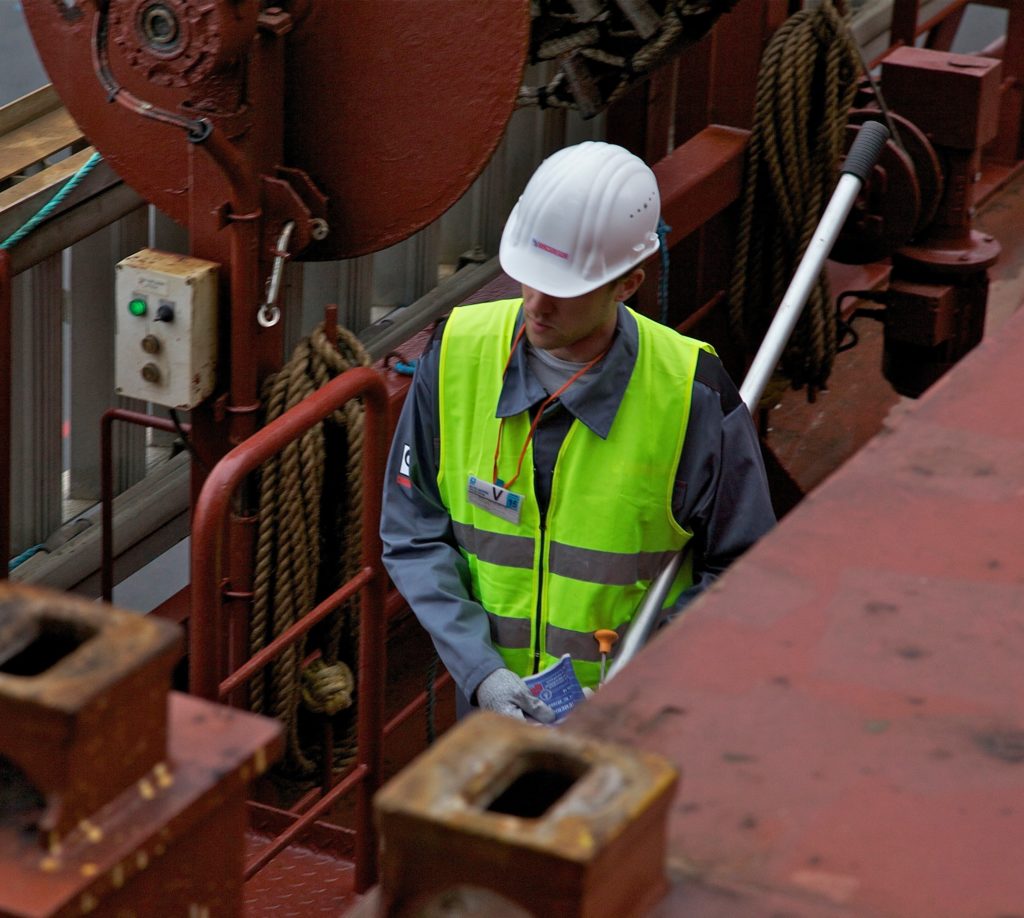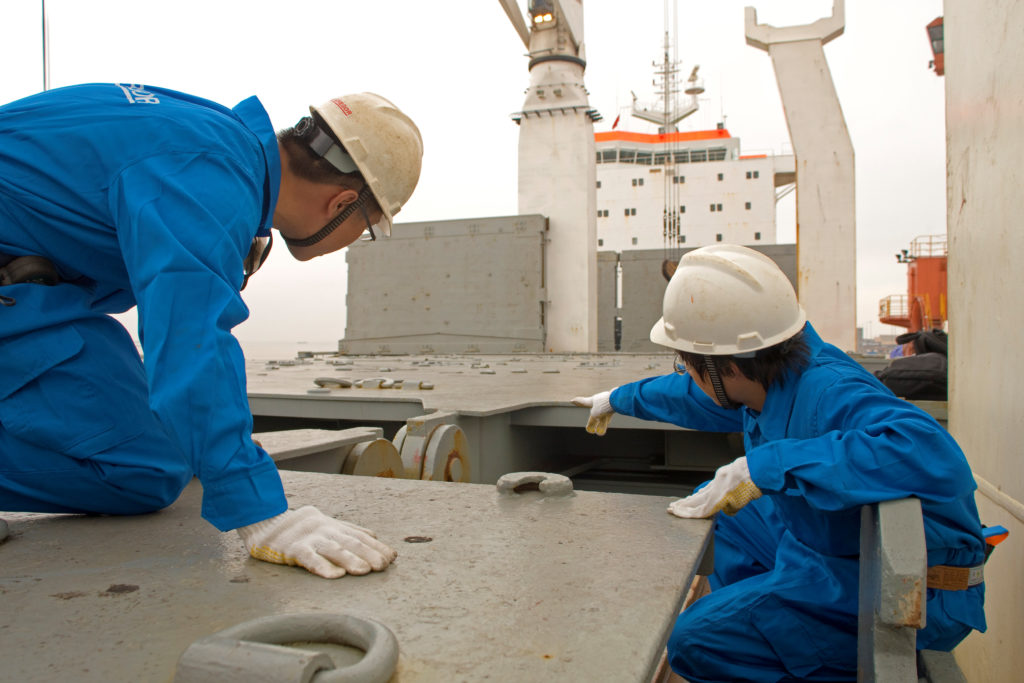Drydocking pre-inspection avoids future pain
Sometimes costly, periodically mandatory and ultimately inevitable, the drydocking is part of the normal life of a ship. However, with days in dock also experienced as lost earnings, the stakes are high for what is a rare opportunity to deal with the safety, environmental and efficiency issues that cannot be handled in service.
MacGregor recently created a new drydocking superintendent function within its organisation to provide internal and customer-facing focal points for project delivery. The load-handling specialist says that adding new oversight changes the nature of its drydocking service relationship with clients and offers a chance to increase mitigation against the risk of late ship redelivery.
Among those filling the newly formalised ‘Drydock Superintendent’ role are Luca Andreozzi and Kai Büsing, two individuals with long industry experience who have been appointed from within the MacGregor ranks. Both superintendents coordinate drydocking to support MacGregor’s broad portfolio of cargo access and load handling equipment, liaising with the supplier’s teams of locally-based experts who support shipyards and owners in maintaining OEM-based equipment performance standards.

Luca Andreozzi

Kai Büsing
Scheduled planning
Büsing says that MacGregor is now offering to start planning as much as a year ahead of a scheduled drydock, to ensure that all parts are fully tested, approved and in position for timely installation.
“It’s no secret, with supply chains routinely disrupted, that ordering steel parts that must be fabricated or sophisticated electronic parts should be done on a ‘sooner the better’ basis,” comments Andreozzi. “Late redelivery after a drydocking is counted in off-hire time and resulting costs.”
With Andreozzi covering ships drydocking around the Mediterranean and Büsing mainly focusing on Germany, the superintendents offer different accounts of customer attitudes and expectations where repair services are concerned. However, both emphasise pre-docking inspection (PDI) as an increasingly powerful tool for ensuring that drydock work is planned for relevance, thoroughness and time efficiency.
Formal approach
“Crew report maintenance issues to the ship’s owner or manager on a continuous basis, while marine engineers are renowned for their resourcefulness in getting machinery working,” explains Andreozzi. “However, checking equipment prior to drydocking against the operating manual to establish condition, based on safety parameters, potential operating risks and repair requirements needs a formalised approach.”
“After the engine, the readiness of the handling and access equipment to do their job will determine whether the ship itself can work,” says Büsing. “In simple terms, if the quarter ramp is stuck in the open position, then the ship can’t leave port, but suboptimal equipment performance is also of relevance to the charter party agreement, or the vessel’s attractiveness for future hire. Our focus is to maximise our operational availability and to minimise unplanned downtime.”
Where the conventional approach will see planning based on experience, owners will wait for the drydock to take full stock of requirements. The PDI allows MacGregor to identify current issues long before the drydocking and make its recommendations ahead of time. “We are not in direct contact with individual ships as such, but as ex-service engineers we are fully aware of the nuances involved in the dialogue,” adds Büsing.
Once the PDI is underway on board, capturing digital images is a key part of establishing the real condition of equipment in service, he says, so that effective maintenance can be planned for – “not just general requirements based on its age.”

Service man carrying out an inspection in port of Bremerhaven
Planning resource
“We are anticipating forthcoming surveys and liaising directly with customers to share our insights with them on what their needs will be and the advantages of planning for potential solutions,” Büsing adds. “We already have the service reports for our equipment in the system to access before we go on board.”
Sometimes, customers use competitor services so MacGregor may not have access to all documentation, Büsing acknowledges, while Andreozzi says that customer records may not always be exhaustive.
Nevertheless, the PDI is a ‘value add’ just because it works from the most comprehensive records available to the OEM and provides a platform for better drydocking management for the client.
“Over the years, MacGregor has supplied equipment for installation on board something like 30,000 commercial ships, so you can see that pre-inspection service capability is significant for drydocking efficiency – for us, but also for a reasonable slice of commercial shipping,” Andreozzi observes.
However, Büsing adds that customers can overlook benefits where straightforward maintenance is concerned. “Customers will feel comfortable taking care of hatchcover renewal or deck machinery maintenance and see the PDI as only relevant when they know that cranes or steering gear need to be repaired or upgraded.”
Simplicity itself
“The pre-docking inspection gives MacGregor the opportunity not only to assess and coordinate parts despatch, but also to coordinate where and when those parts are most usefully delivered, and at what point MacGregor personnel should attend the docking project,” adds Andreozzi. The PDI also offers an opportunity for MacGregor to give clients fair warning of obsolescence or any approaching non-compliance issue where their shipboard systems are concerned.
“In a recent case involving a post-Panamax container ship, we identified that steering gear pumps were obsolete four months ahead of drydocking. While the system was still functional, our health check led on to pump exchange and refurbishment being included seamlessly in the drydocking. That project led on to another with the same owner.”
Andreozzi points out that an owner ordering well in advance of a drydocking is also less vulnerable to price inflation than one seeking parts for immediate delivery, adding that the moderate costs associated with a PDI can be quickly dwarfed by a hard-to-find spare.
But so convinced is MacGregor that the PDI approach works that the company is offering daily inspection prices that are not only fixed but deductible from the cost of spares over a pre-agreed minimum.
“I think it’s fair to say that once we get the PDI service in front of customers they immediately see benefits,” adds Büsing, “but perhaps they still don’t recognise the full potential. They see that doing this now and saving two weeks off-hire later is a clear win, but still struggle with the cost of travel for a service engineer. That’s why we came up with the fixed day rate offer that is also deductible.”
“If you bought a certain number of spares, I suppose you could look at it as a free pre-inspection,” comments Andreozzi. “But I think it’s really more of an acknowledgement that the PDI has mutual benefits for both sides.”

MacGregor Cranes, Hatch covers and Service, Shanghai
More articles like this can be found in the latest issue of DryDock magazine





